
The European market potential for recycled fashion
Recycled fashion is a relatively small, yet fast growing product segment in Europe. Stricter legislation and increasing consumer awareness about the negative impact of fast fashion are forcing brands and retailers to incorporate circular concepts into their product and business strategies. Manufacturers from developing countries that can keep up with new technologies and solutions to create fashionable apparel from recycled and recyclable materials will be at an advantage.
Contents of this page
1. Product description
According to the European Environment Agency, in 2020, European textile consumption had “on average the fourth-highest negative lifecycle impact on the environment and climate change” (after food and drink, transport and housing) compared to other consumption categories. It created the third-highest pressures on water and land use and had the fifth-highest use of raw materials and greenhouse gas emissions.
The average consumer furthermore buys 60% more items of clothing today compared to 15 years ago, and items are kept only half as long, generating huge amounts of waste. Globally, 87% of all disposed textiles is sent to landfills or incinerated.
While the fast fashion industry encourages overconsumption and waste, recycled fashion turns waste into value. At scale, it could dramatically reduce the sector’s environmental impact.
The simplest definition of ‘recycled' is ‘used again’. In the fashion industry, this means the reuse of materials and/or finished garments that have been or would otherwise be thrown away.
Recycled fashion is a core concept of the circular economy in the apparel industry. According to the Ellen MacArthur Foundation, a circular economy keeps products and materials in circulation through processes of maintenance, reuse, refurbishment, remanufacture, recycling and composting.
Recycled fashion refers to garments that:
- Are made (at least in part) from materials that have been converted from waste materials (recycled materials);
- Have been worked on to create a new use (upcycling through remanufacture or refurbishment);
- Have been worked on to allow continued use (repair);
- Have had multiple users (donated, borrowed/shared, rented, resold);
- Have been used multiple times by a user as an alternative to consuming new items;
- Are disassembled and the parts reused and/or converted into new materials; and
- Are composted (after all other reuse options have been considered).
For recycled fashion to maximise its impact, new products have to be designed from the outset to minimise waste and promote reuse. According to the Ellen MacArthur Foundation, 80% of a product's environmental impact is influenced by decisions made at the design stage.
Figure 1: Denim is a pioneer category for recycled material and circular concepts
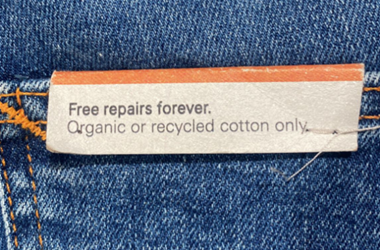
Source: Photo by Forward in Fashion
For producers, the most important design considerations for products that will be reused long-term through rental, resale, sharing, donation, repair or longer use per user are durability, high quality and timelessness.
Two types of products currently offer the most opportunities for developing country exporters to Europe: products made from recycled materials and products that are designed to be recyclable. The quality and sustainability of raw material and chemical inputs are key considerations for producers.
Products made from recycled materials
Recycled textile fibres can be produced from pre-consumer and/or post-consumer waste. Pre-consumer waste can be fabric scraps from the cutting room and defective garments. Post-consumer waste includes discarded textiles (fibre-to-fibre recycling) as well as materials from other industries, including plastic bottles, fishing nets, food waste and even car tyres.
To claim that a product is made from recycled materials, the Recycled Claim Standard (RCS) requires a minimum recycled content of 5%. The Global Recycle Standard (GRS) is stricter and requires a minimum of 20% recycled content for business-to-business certification and a minimum of 50% recycled content to qualify for product-specific labelling.
Between 2014 and 2019, the number of RCS-certified facilities grew ninefold. Until now, brands have disproportionately focused on the use of recycled fibres from alternative sources as a route to circularity due to the difficulties of fibre-to-fibre recycling.
Examples are REPREVE®, a performance polyester fibre made from recycled plastic bottles diverted from landfills and oceans, and ECONYL®, a regenerated nylon made from old carpets and discarded fishing nets. Both fibres have the same performance and quality as virgin fibres. A study of the top 5 European fashion markets revealed that while 29.1% of recycled clothing is made from 100% recycled polyester, less than 1% is made from 100% recycled cotton. As a result, product categories where recycled fibres are used most are those that use a higher percentage of synthetic fibres, such as outerwear and swimwear.
Products that are designed for recyclability
Of all sorted and separately collected waste in the EU, around 54% is reused (second-hand market, donated, exported outside Europe), 32% is converted into low-value products (such as wipers, cleaning cloths, insulation materials) by means of mechanical recycling, 7% is incinerated, 5% is landfilled and only 2% (PDF) is recycled into higher-value applications such as textile fibres to make new garments.
To boost post-consumer apparel recycling rates, certain challenges need to be overcome, including:
- Underdeveloped collection, sorting and pre-processing capacities;
- Capacities for chemical recycling (such as of polyester) are not advanced enough for scale;
- Complicated and costly garment disassembly due to a high number of trims;
- Garments with stretch properties can make recycling difficult due to elastane content;
- Current recycling capabilities have limited ability to handle fibre blends;
- Some components (such as bondings, heat transfers and silicone prints) are unrecyclable;
- Fibres lose strength and quality in the mechanical recycling process, resulting in lower-quality fabrics that are not recyclable and have to be blended with virgin fibres;
- Some toxic chemicals used to dye and finish certain fabrics prevent recyclability;
- When products combine components from various suppliers, it is challenging for brands to know what products are made of and how they were produced; and
- Inadequate sorting services and technologies.
The industry is developing innovative solutions to these barriers to recyclability, but producers can also address many of them through their own design and sourcing choices.
2. What makes Europe an interesting market for recycled fashion?
The European Union (EU) is the world’s leading clothing import market. According to Trademap and Eurostat data, the EU accounts for as much as 27% of all global apparel imports and the market grew by an average of 6.75% a year in the 2017-2022 period.
Between 1996 and 2018, clothing prices in the EU decreased by more than 30% relative to inflation, yet average household spending on clothing increased. Globally, the EU is one of the biggest sources of fashion overconsumption and waste. This is fuelled by its large fast fashion industry, which produces a seemingly endless supply of low-quality cheap clothing and encourages low clothing utilisation.
European textile consumption averages 26 kilograms per person per year (includes clothing, shoes and household textiles). This high EU consumption has a huge direct impact on the environment. According to the European Environment Agency, it requires on average 400 m2 of land, 9 m3 of water and 391 kg of raw materials, and has a carbon footprint of 270 kg per person per year. According to a 2023 European Impact Assessment Report (PDF) by the European Commission, EU countries also generate more than 5 million tonnes of textile waste per year, which comes to just over 11 kg per person.
As recycling capacity in Europe is limited, a large share of discarded and donated clothing is exported to Africa and Asia, much of which eventually ends up in landfills. In the 2 decades between 2000 and 2019, the volume of used textiles exported from the EU tripled.
The need to scale up recycled fashion (particularly fibre-to-fibre recycling) in Europe has never been as urgent as it is now. What is more, experts predict that, with the right level of investment, fibre-to-fibre recycling could reach as much as 26% of gross textile waste by 2030, becoming a self-standing industry worth €1.5 billion to €2.2 billion in profits.
Europe is the ‘leading global pathway towards sustainable clothing’
The EU is stepping up legislation to make recycled and circular products the norm.
Under the EU waste directive, EU countries must collect textiles separately by 2025. Collection rates in the EU are predicted to more than double by 2030 as a result. The European Commission has also proposed a new Waste Shipment Regulation aimed at reducing the amount of waste that can be exported abroad and encouraging recycling and reuse within the EU.
The EU Strategy for Sustainable and Circular Textiles aims to ensure that, by 2030, textile products placed on the EU market are “long-lived and recyclable and to a great extent made of recycled fibres”.
Key measures include:
- Setting design requirements for textiles, including mandatory minimums for recycled fibre content.
- Introducing clearer information on textiles and Digital Product Passports.
- Improving the business and regulatory environment for sustainable and circular textiles.
- Providing incentives and support for circular materials and production processes.
To align with this strategy, the Commission is proposing mandatory extended producer responsibility (EPR) schemes for textiles in all EU member states. EPR legislation would hold producers responsible for the end-of-life disposal of products they sell (collection and recycling into new material).
It is therefore in the interests of European brands and retailers to design clothing with recycling and circularity in mind from the start. Designers are choosing to use fewer trims and embellishments, higher-quality fabric and finishing effects and more advanced sustainable dyes and techniques.
The European fashion industry is also scaling up the use of materials made from recycled inputs rather than virgin materials. In 2021, H&M – which is a sustainability leader in the fashion segment – increased the share of recycled materials used in its garments from 5.8% to 17.9%. Swedish brand Haglöfs has set an ambitious target to use recycled or renewable materials in 100% of its main fabrics by 2025. And Inditex is committed to achieving 100% use of sustainable or recycled linen and polyester by 2025.
Consumer awareness about sustainability is also increasing in Europe. Studies show that as many as 38% of consumers in Europe’s 5 largest markets consider fashion brands’ social and environmental impact when shopping. Although recycled clothing is still a niche market, the number of clothing items available in these countries that were made from recycled materials grew by on average 147% a year between 2018 and 2021, compared to only 28% for clothes made from virgin materials.
Taking recycled fashion from niche to mainstream requires better fibre-to-fibre recycling infrastructure and solutions as well as effective brand and consumer awareness initiatives. Europe already has many recycling plants with solutions in different stages of commercialisation. Capacity for fibre-to-fibre recycling is therefore increasing.
The European Commission’s ReSet The Trend campaign was launched to engage Europeans in the battle against fast fashion and to raise public awareness about the EU Strategy for Sustainable and Circular Textiles. Europe is also home to some of the industry’s most active multi-stakeholder initiatives for research and collaboration in circular innovations, including Fashion for Good, the Laudes (formerly C&A) Foundation, the H&M Foundation and the Ellen MacArthur Foundation.
European recycling innovations that have received EU funding include CISUTAC (Belgium), Fibersort (the Netherlands), New Cotton Project (EU), T-REX Project (EU), OnceMore® (Sweden/Austria) and the WhiteCycle project (EU), amongst many others.
Suppliers that work with European brands and retailers will have access to the latest knowledge and technical innovations driving global trends in recycled fashion.
Tips:
- Between 25% and 40% of all fabric used in factories worldwide is left over or becomes waste. Suppliers can form local factory collectives to organise the recycling of pre-consumer waste.
- Create a story around the recovery, recycling and/or upcycling of your pre-consumer waste. Communicate this with buyers through your website and other sales material. Quantify and share your targets and achievements.
- Where possible, design your products to meet the minimum requirements for recycled content and labelling. Visit the websites of key apparel brands and retailers in your focus market(s) to see what targets they are committing to and what approaches they are taking (certification, material innovations, and so on).
3. Which European countries offer most opportunities for recycled fashion?
The European markets with the most potential for recycled fashion are Germany, France, the Netherlands, Italy, Belgium and Sweden. They have been selected based on a combination of factors, including:
- Market size – indicated by high apparel imports, import growth and high levels of waste.
- Consumer demand – indicated by sustainable consumer behaviour data.
- Strength of policy-making – indicated by country sustainability performance.
- Feasibility – indicated by textile waste collection rates.
Together, this group of countries accounted for as much as 62.5% of all EU apparel imports in 2022.
Table 1: Comparison of EU country market potential indicators for recycled fashion
|
Country |
Apparel imports 2022 (Euros) |
Average import growth 2017-2022 |
Household consumption of clothing 2020 (Euros per capita) |
Waste generated per year (thousand tonnes) |
Proportion of waste collected |
2023 Rank Sustainable Development Goals Index |
Sustainable behaviour index |
|
Germany |
€41.8 bn |
6% |
€640 |
1267 |
62% |
4 |
7* |
|
France |
€25.7 bn |
5% |
€430 |
517 |
39% |
6 |
6 |
|
Spain |
€21.2 bn |
6% |
€330 |
451 |
21% |
16 |
14 |
|
The Netherlands |
€19.2 bn |
7% |
€770 |
305 |
45% |
20 |
2 |
|
Italy |
€18.3 bn |
7% |
€710 |
615 |
39% |
24 |
23 |
|
Poland |
€13.2 bn |
17% |
€290 |
362 |
18% |
9 |
26 |
|
Belgium |
€9.3 bn |
4% |
€630 |
213 |
55% |
19 |
8 |
|
Austria |
€6.6 bn |
3% |
€810 |
146 |
30% |
5 |
11 |
|
Denmark |
€5.5 bn |
8% |
€750 |
85 |
42% |
3 |
3 |
|
Sweden |
€5.4 bn |
8% |
€570 |
62 |
62% |
2 |
1 |
*Note: West Germany only
Sources: Eurostat, European Commission, EURATEX, Sustainable Development Solutions Network, University of Padua
All 6 countries have strong national policy commitments and proactive public initiatives specifically addressing textile waste and recycling. This is reflected in higher waste collection levels in proportion to waste generated and/or in consumer behaviour. Commitments include extended producer responsibility (EPR) schemes and aggressive targets for both post-consumer textile waste recycling and recycled material content in new products.
While Spain and Poland both rank high on apparel imports and textile waste, they have low collection rates (21% and 18%, respectively, compared to the EU average of 38%) and consumer awareness about sustainability issues is also relatively low. However, Poland is one of the EU’s key textile recycling sorting hubs and imports large amounts of textile waste for this purpose.
Germany – EU’s leading recycler of household waste could set the standard for textile waste recycling
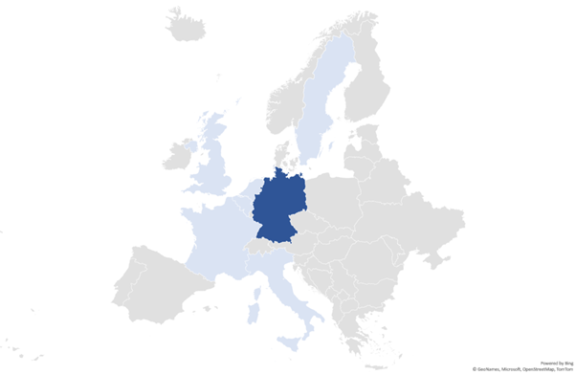
Germany was the top recycler of municipal waste in the European Union in 2021. With an estimated recycling rate of 71.1%, it has already topped the latest EU targets of 55% by 2025, 60% by 2030 and 65% by 2035. This is the result of strong government policies, high public awareness about and acceptance of recycling, and a robust household waste sorting system.
Ahead of the 2025 EU requirement for separate collection of textile waste, Germany has developed a draft revision of national waste legislation transferring responsibility for textile waste collection from households to municipalities. Already the European leader in textile collection, this may help the country improve its current low rate of recycling into higher-value textiles.
Germany has its own government-run social and environmental certification label called Green Button (PDF), which is displayed on garments at point of sale and helps consumers make more informed purchasing decisions. Green Button certification recognises the Global Recycling Standard as proof of compliance in the auditing process. Certification is an important requirement for suppliers of German brands.
Fibre-to-fibre textile recycling plants whose technology/services have reached commercial stage include I:CO and Altex.
Brands focusing on recycled and/or recyclable materials include ARMEDANGELS, pinqponq and VAUDE.
France – A pioneer in the implementation of extended producer responsibility
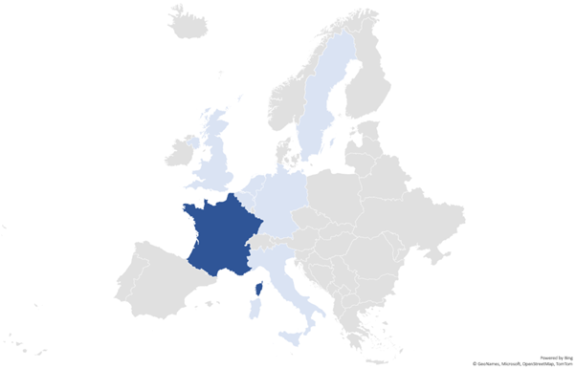
While not the highest in the EU, France’s textile collection rate is growing thanks to ambitious policies. France is the only country to already have an ERP system in place (since 2007) banning the destruction of unsold textile products and setting the following targets:
- 50% of all textiles placed on the market must be collected
- 95% of textiles collected must be reused or recycled
Prior to EPR adoption, collection rates were low, at only 18% in 2010 compared to the current 39%.
France is one of the EU countries closest to implementing the 2025 separate textile collection requirement. The country has specific regulations for this and a well-established collection system with 47,400 self-deposit points, equal to one per 1,422 inhabitants.
Refashion is the organisation designated with overseeing waste management and resource preservation through the collection, recycling and recovery of used textiles. Textiles are sorted according to a 5-level waste hierarchy. Refashion is financed by 95% of French brands and importers through a fee system under the EPR scheme. Its income goes into communication (awareness and information campaigns) and research and development. The organisation’s Eco design platform offers a step-by-step guide for switching to sustainable materials. Its Recycle platform connects textile recycling stakeholders.
France is prioritising the provision of clearer consumer information at point of sale (in line with the EU Strategy for Sustainable and Circular Textiles goals). Informing consumers about products that contain substances on the EU REACH Substances of Very High Concern (SVHC) list is already a legal requirement, and the government has also proposed a mandatory environmental rating and labelling system for apparel and textile products, based on the environmental credentials of each garment.
New fibre-to-fibre textile recycling innovations in France include Weturn and Carbios.
Brands focusing on recycled and/or recyclable materials include Circle Sportswear, VEJA, Nénés Paris, Ekyog, 1083 jeans and HOPAAL.
The Netherlands – Europe’s circular fashion capital
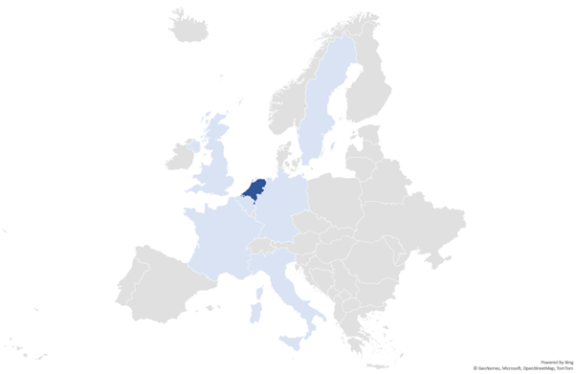
The Netherlands aims to have a circular economy by 2050 and is rolling out ambitious policies and incentives to achieve this. Targets for 2030 include:
- all textile products should contain 50% sustainable materials, of which at least 30% is recycled content
- 50% of post-consumer material is recycled
These targets provide incentives for Dutch brands and retailers to prefer suppliers with recycled materials sourcing and development capabilities (fabrics and trims).
The Netherlands is home to a strong community of industry support organisations centred mainly around sustainability issues. Amongst them is Fashion for Good, a global initiative for sustainable fashion and an accelerator for circular fashion start-ups. The organisation connects sustainable innovators with brands, retailers, manufacturers and funders. Of the 12 innovators selected for its 2023 Innovation Programme, 4 are recycling technologies. The organisation has also created the world’s first interactive museum dedicated to sustainable fashion.
Amsterdam is home to a thriving fashion sustainability start-up scene as well as numerous businesses, designers, events and foundations focused on sustainable and circular design, including the fashion retailer C&A, which introduced the world’s first Cradle to Cradle Gold Certified® jeans.
Fibre-to-fibre textile recycling plants whose technology has reached commercial stage include Wolkat and CLS-Tex. New fibre-to-fibre textile recycling innovations include SaXcell and CuRe Technology.
Brands focusing on recycled and/or recyclable materials include MUD Jeans and Kuyichi.
Italy – Italy’s long history in fibre recycling provides a blueprint for expansion
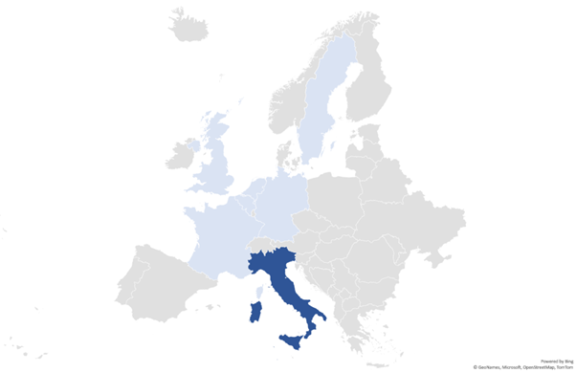
The Italian government has put a particular focus on the textile sector and is investing in strengthening its separate collection network and creating new plants for recovery, reuse and recycling. The goal is to regenerate 100% of textile waste in the coming years. In February 2023, a draft decree was issued outlining Italy's plans to create an EPR system for the textile supply chain.
The textile region of Prato in Italy has been recycling wool since the mid-nineteenth century. Need and poverty led different areas of the region to specialise in different steps of the recycling process. Around 160 companies are members of the Prato-based Italian Textile and Recycling Association (Astri), dedicated to strengthening the production of regenerated textiles.
The Prato region has developed its own ‘Cardato recycled’ trademark for recycled wool fabrics and yarns produced in the Prato district and made from at least 65% recycled material (clothing and textile scraps). To display the trademark, fabrics and yarns must also measure their entire production cycle’s environmental impact using a lifecycle assessment created by Prato textile industry stakeholders. This is one of the first examples in Europe of the use of a simplified approach to the lifecycle analysis (LCA) method to promote its adoption by small and medium-sized companies.
Italy’s expertise in all aspects of the textile and garment industry and its collaborative approach across the supply chain enables it to respond quickly and effectively to changing industry needs. This includes designing for circularity, materials development, traceability and supply chain monitoring.
The Italian textile and apparel manufacturing industry has faced intense competition from developing countries in recent decades. More as well as more diverse locally recycled fibre production could bring more high-quality textile and apparel production back to Italy.
Italy is home to Acqafil S.P.A., which manufactures ECONYL®, the world’s leading regenerated nylon fibre. More than 2,500 brands use ECONYL®, and sales of ECONYL® increased by as much as 52% in 2022.
Brands focusing on recycled and/or recyclable materials include Diesel, Rifò and OVS.
Belgium – Northern region of Flanders a top performer in overall waste management
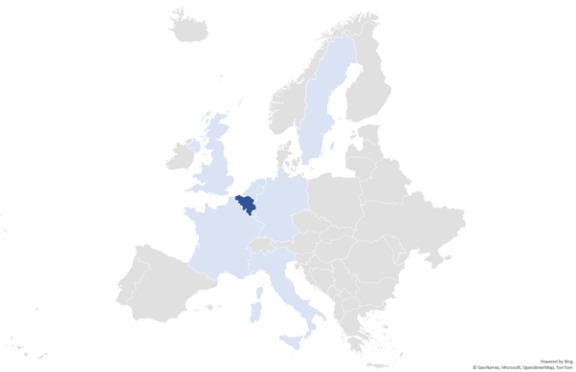
One of the most densely populated parts of Europe, the Flanders region in northern Belgium aims to be zero-waste by 2050. Reuse has long been a focus for the region, which has a large network of government-subsidised local second-hand (kringloop) shops.
More than 3 decades of ambitious waste-reduction policies have made Flanders amongst the world leaders in waste collection and processing. The region has the highest waste diversion rate in Europe, as around 75% of residential waste is reused, recycled or composted.
According to Statista, in 2020, Belgium generated the second-highest amount of textile waste per person in the European Union, after Luxembourg. Textile waste is 1 of 6 priority waste streams in the country’s household waste implementation plan.
Vanotex is a mechanical recycling plant that has been in operation since 1975.
Brands focusing on recycled and/or recyclable materials include HNST, Conscious Antwerp and go as u.r.
Sweden – Europe’s ‘greenest’ country

Culturally, Scandinavian countries are known for having a deep sense of connection to nature. According to the 2021 Sustainable Brand Index, the top issue that Swedish consumers want companies to prioritise is recycling and reuse. As many as 67% of Swedes discuss sustainability with friends and family (from occasionally to often). The region also has many sustainable fashion brands committed to changing the fashion industry for good. These brands focus on high-quality sustainable materials, waste minimisation and transparent supply chains.
The use of recycled fibres is becoming the new standard for many Scandinavian, including Swedish, brands and the percentage of recycled content is increasing. Outdoorwear brand Houdini has been making recycled garments since 2006 and claims that 85% of its collection is already made from recyclable materials.
The Swedish government has set ambitious goals for sustainability across all sectors. Sweden introduced an EPR for textiles in 2022, which will be enforced from 1 January 2024. Swedish targets include 90% reuse or material recovery of collected textile waste and a 70% reduction in textiles sent to landfill by 2028.
Recycling plants in the semi-commercial stage that have plans to significantly scale up operations by 2025 include Södra (which makes OnceMore®) and Renewcell (which makes Circulose®). Both are pulp made from cellulosic textile waste, from which textile fibres can be produced.
Swedish brands focusing on recycled and/or recyclable materials include H&M, ASKET, Boob, Nudie Jeans, Houdini, Fjällräven and Swedish Stockings.
The United Kingdom

The United Kingdom (UK) is one of the top importers of apparel globally, with a market share of 5.2%, including 4.6% of the knitwear (HS code 61) and woven garments (HS code 62) markets. The population buy more clothes per person than any in other country in Europe. Described as “the epicentre of fast fashion in Europe”, the UK generates more than 1 million tonnes of textile waste each year.
The UK government has announced a new programme aimed at reducing waste, maximising resources, keeping products and materials in circulation for as long as possible and increasing recycling across 7 key sectors, including textiles. This programme includes proposals for an EPR scheme for the textile industry.
The UK recycling plant Worn Again claims that 80% of post-consumer waste can be processed by its technology (currently in pilot stage), which can separate polyester/cotton fabric blends. A new plant is being built in Switzerland.
Brands focusing on recycled and/or recyclable materials include Rapanui, Neem, Fanfare, Stay Wild and Stella McCartney.
Tips:
- Visit the Fashion for Good website to learn about innovations and resources available to producers seeking to implement more sustainable fashion approaches.
- Look into getting RCS or GRS certification for your facility and products. There are many certifiers to choose from, including SCS and TÜV SÜD.
- Circular Fashion has developed a Circular Material Library to aid in sourcing innovative, sustainable and recyclable materials.
4. Which trends offer opportunities or pose threats for the European Recycled Fashion market?
Trend 1 - Transparency is driving progress
A recent screening of sustainability claims in the textile, garment and shoe sector suggested that 39% could be false or deceptive (a concept called ‘greenwashing’). The EU is implementing several policies to help consumers make more informed, sustainable choices.
In March 2023, the European Commission adopted a proposal for a Green Claims Directive (GCD) aimed at preventing brands and retailers from making false sustainability claims to consumers. The GCD will require companies to back up their environmental claims with data. Textile products placed on the EU market will soon also need an individual Digital Product Passport (DPP), which is a digital record of a unique product’s complete lifecycle. Brands are therefore starting to map out their supply chains and capture impact-related data.
The European Commission is specifically concerned about brands’ claims that using recycled polyester makes their products sustainable. These claims can be misleading when the plastic polymers used do not come from fibre-to-fibre recycling, but from PET bottles. In fact, the practice of using PET bottles to make textile fibres diverts them from being used in a closed-loop system for food contact materials.
Industry initiatives are also calling on brands and retailers to disclose more information about their sustainability efforts. Fashion Revolution’s Fashion Transparency Index tracks 250 leading brands’ performance on the information they are able (and/or willing) to disclose. Its 2023 index revealed that policies on product and textile waste and recycling was one of the topics that brands are least transparent about. This situation is set to change.
Remokey is an example of how technical solutions are helping producers to more accurately market their recycled products. Their solution calculates the benefits of using recycled materials in a product and translates this data into clear figures displayed on labels.
There are increasing opportunities for suppliers to differentiate themselves and add value by creating a fully transparent supply chain. By collecting and sharing accurate and reliable data on materials and processes from their upstream partners, suppliers can help brands and retailers to more accurately measure and report their progress.
Sustainable brands and retailers are increasingly sharing information about their efforts to become more sustainable. They recognise that the only way to achieve a circular industry is to create more demand, which in turn will force innovative new products into the mainstream supply.
Houdini (which openly shares information about materials and suppliers) states that it never seeks exclusive rights to a material as it believes that the more companies use sustainable materials, the better.
Trend 2 – More traditional retailers and brands are adopting circular fashion business models
Near-term inflationary pressures and increased environmental concerns amongst consumers are boosting the rental and resale fashion markets. In Europe, ‘pre-loved’ and ‘vintage’ clothing have gained not only acceptance but popularity across the apparel industry.
In recent years, a growing number of platforms have started to offer clothing rental and resale (such as Rent the Runway, MY WARDROBE HQ, Vinted and Vestiaire Collective). New platforms are emerging for peer-to-peer sharing/rental (such as HURR and By Rotation), and retailers and brands across value segments are increasingly getting in on this trend, including Houdini, H&M, Zara, Selfridges and Galleries Lafayette.
Europe’s second-hand apparel market was estimated to grow at an average annual rate of 8.4% between 2022 and 2023, with rental and resale business models potentially accounting for 23% of the global fashion market by 2030.
Both of these business models lengthen product lifecycles and encourage reuse as an alternative to buying new. As a result, they have the potential to reduce the number of new garments imported by European companies, especially in the premium, luxury and performance clothing segments. However, as more mainstream brands and retailers become more directly involved in the rental and resale market, differentiation, quality and durability will likely be increasingly ‘designed into’ special collections, presenting new opportunities for many suppliers.
Spectre
Spectre is an apparel manufacturing company with offices in Denmark and Germany and factories in Vietnam and Lithuania. Spectre advertises itself as a sustainable manufacturer of functional garments (mainly outerwear). The company is ISO14001 and SA8000-certified and publishes an annual impact report. It is also highly transparent about its environmental and social impacts, ambitions and results, including material sourcing (including the percentage of recycled fabrics used), energy and water use and labour standards.
Tips:
- Currently, the most effective way to provide transparency is through certification. Check the CBI studies on social responsibility and green technologies for an overview of certifications and standards.
- Choose raw materials from suppliers that can give you total transparency about their products.
- Various circular design guides are available free of charge, including from ASOS (PDF), H&M, Circular Fashion (PDF), the Jeans Redesign project and Bestseller (PDF).
- Focus on higher quality, durable and sustainable products that are more recyclable as well as easier to resell, rent and repair.
FT Journalistiek carried out this study on behalf of CBI.
Please review our market information disclaimer.
Search
Enter search terms to find market research
